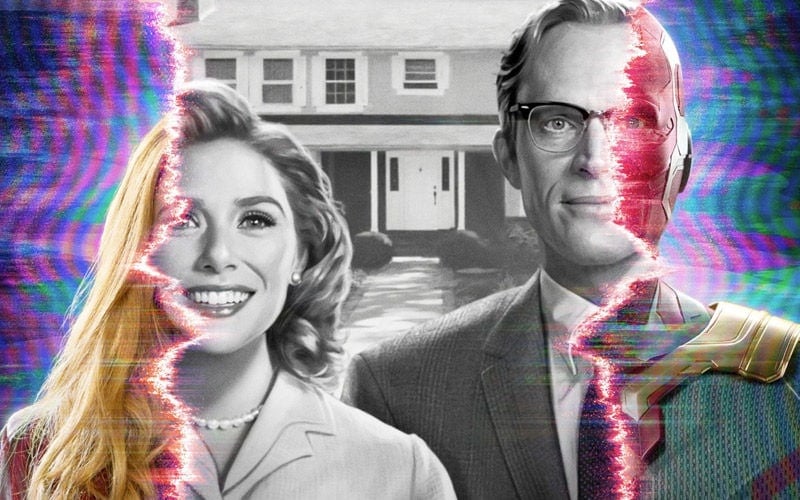‘WandaVision’ Miniseries Review: Grief and Trauma

Spoilers Below
WandaVision, developed by Jac Schaffer, uses the MCU’s Wanda Maximoff and Vision along with a meta sitcom storyline to explore grief. After losing Vision in Avengers: Endgame, Wanda numbs her grief by creating a Sitcom World in Westview, New Jersey. She makes a perfect family with Vision. Every day is a new sitcom episode taking place in a different decade where nothing truly horrible can ever happen.
WandaVision is full of suspense and mystery. Acting Director of S.W.O.R.D. Tyler Hayward and witch Agatha Harkness are minor archenemies of our superheroes, but the real villain is trauma. Wanda only becomes Scarlet Witch when she faces her pain head-on and finds new strength within herself.
The Fake Pietro Maximoff (Quicksilver) storyline is a big letdown. Evan Peters plays Fake Pietro. Peters played mutant Peter Maximoff (Quicksilver) in the X Men Universe, which includes movies like X Men: Days of Future Past and Deadpool 2. When Fake Pietro first shows up at Wanda’s door at the end of “On a Very Special Episode …” I was hopeful that the character was Peter from the X-Men Universe. Perhaps Mutant Quicksilver is here to convince Wanda to free the people of Westview from her sitcom illusions. I mean, Fake Pietro does have all of Quicksilver’s speed. But I was also worried that Peters playing Fake Pietro was just an Easter Egg for X-Men fans. When “Breaking the Fourth Wall” reveals that Agatha is pulling Fake Pietro’s strings, I then thought it was possible that the witch somehow crossed the multi-verse to kidnap Peters.
Peters is the perfect Fake Pietro since he is the X-Men Alternative version of Wanda’s real twin brother. My hopes were dashed when Fake Pietro turns out to be local actor Ralph Boehner. Schaffer and the rest of the WandaVision writers had an opportunity to be MCU’s first introduction to the Multi-Universe, but instead, they just wrote a weak vulgar pun and a cute Easter Egg.
All of the MCU and sitcom references enhance the joy of watching the Disney Plus miniseries. The episodes are chock full of MCU Easter Eggs, especially from Avengers: Endgame, Captain Marvel, and Avengers: Age of Ultron. One of the leading secondary characters is Monica Rambeau, the daughter of Maria. Maria is best friends with Carol Danvers (Captain Marvel).
In “Previously On,” Monica has visions of Carol and Maria speaking to her as a little girl. These visions are straight out of Captain Marvel. The majority of the episodes are inspired by sitcoms somewhere between the 1950s to 2010s.
For example, “Don’t Touch That Dial” directly references 1960s Bewitched, especially with the opening credit sequence. The sequence is an animated series of scenes where Vision or Wanda is trying to act “normal” around town. In the episode, Wanda spends the entire magic show performance trying to mask Vision’s overzealous use of his powers.
Some of the first seven episodes also have commercials that appear like the ads from a particular decade. These ads also have references to the MCU and the Marvel comics. For example, in the 1970s, The Brady Bunch inspired “Now in Color” contains an advertisement for “Hydra Soak bath powder.” Marvel’s Hydra is an authoritarian paramilitary-subversive organization with its origins in an ancient religious cult and Nazism. Understanding these Easter Eggs helps viewers navigate the story and deepens their understanding of all the characters.
Wanda transforms into the Scarlet Witch when she faces her grief head-on. Episode Eight, “Previously On,” reveals that Wanda tried to say a proper goodbye to Vision. Even though the Avenger was Vision’s next of kin, Hayward blocked her from taking custody of his body. Wanda did not know how her witch chaos power worked, so she unconsciously created a “conditional” Vision and the Westview Sitcom World.
The Westview Sitcom World has enabled her to live in all the lost possibilities that Vision’s death destroyed. Scarlet Witch unconsciously chose sitcoms as the method because it’s always been a comfort source for her, and it’s a space where nothing truly horrible ever happens. But Wanda’s safe space hurt the citizens of Westview since she projected all of her pain into their psyches.
Wanda stole innocent people’s lives so she could deny Vision’s death. S.W.O.R.D. and Agatha trying to steal her “perfect” sitcom world family pushed her into the anger stage of grief. Wanda embraces the reality of her Scarlet Witch identity, accepts Vision’s death, transforms into a superhero, and defeats Agatha. Scarlet Witch drops the Westview Sitcom World illusion, but not before saying goodbye to her twins and Vision. She accepts that their love story is over for now, but her journey as a superhero has just begun. Wanda and Vision leave the possibility open that they may see each other again. He has already gone through several iterations.
I recommend the WandaVision miniseries to anybody who considers themselves a Marvel fan or a sitcom buff. For those who have not seen at least an episode of I Love Lucy, Bewitched, The Brady Bunch, Family Ties, Malcolm in the Middle, and The Modern Family, you should check them out so you can spot all the references. Watching everything from the MCU helps viewers understand most primary or secondary characters’ origin stories. Hopefully, sometime this year, we will all be in the theatres watching Black Widow on the big screen. Meanwhile, watch WandaVision on Disney Plus.


Responses